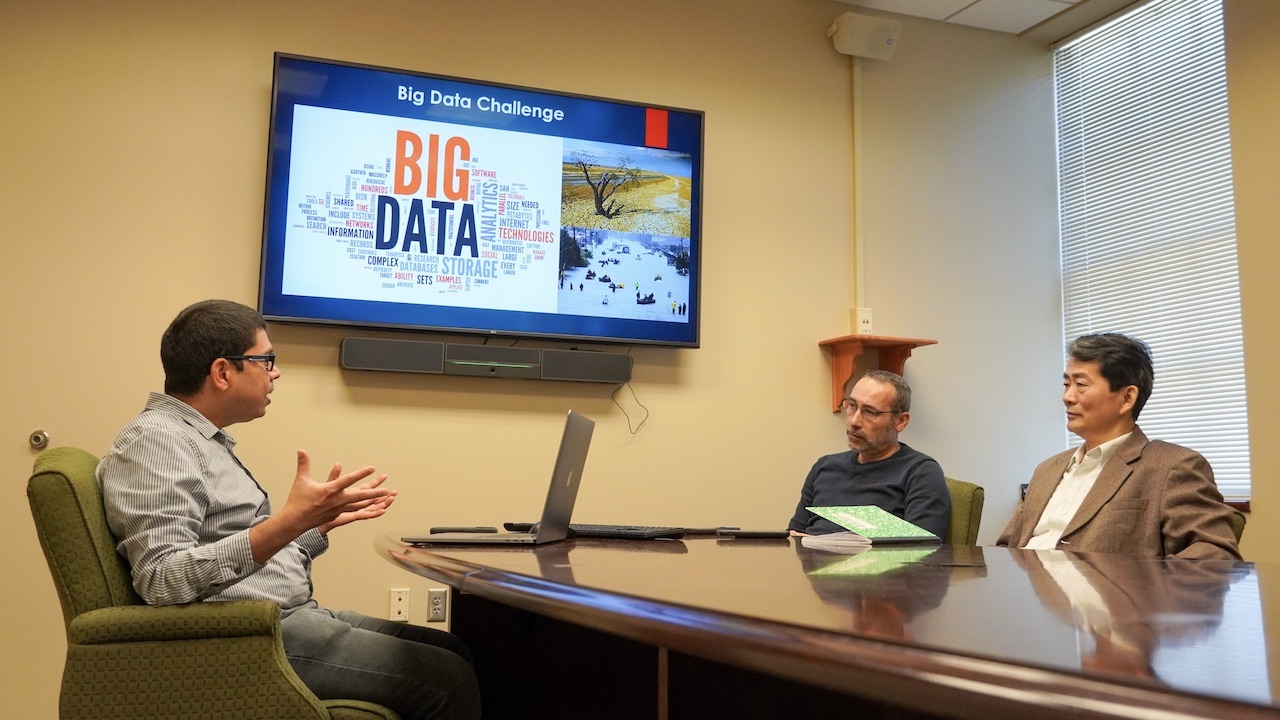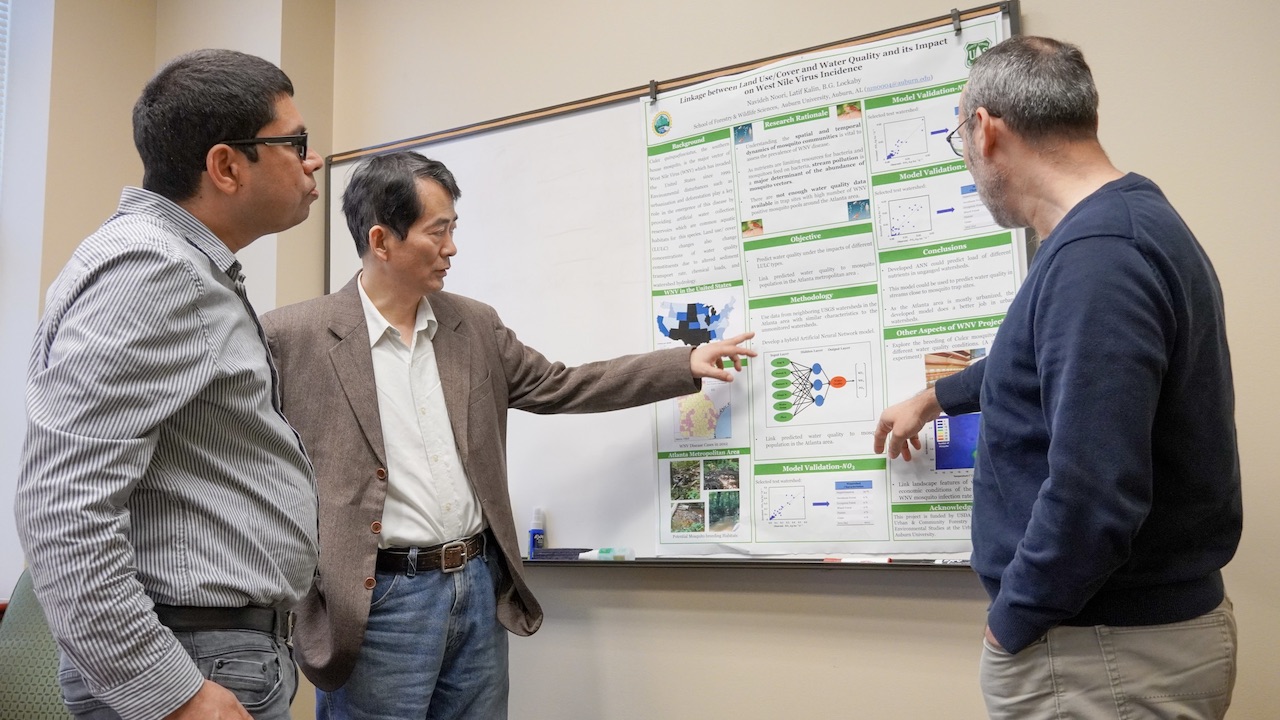content body
Artificial intelligence (AI) and machine learning (ML) continue to emerge with the infinite potential to re-envision the operations of our society and multiple industries.
The College of Forestry, Wildlife and Environment (CFWE) faculty at Auburn University are harnessing the power of AI and ML to better address disparate environmental and natural resources issues and to deliver more effective solutions for communities, citizens and policy makers.
Recognizing AI and ML’s potential for industry problem-solving, CFWE expanded its faculty expertise in Geospatial and Environmental Informatics (GSEI), AI and ML and invested in modern technologies, positioning the college to leverage this wave of innovation for research and teaching.
Scientific trends driving AI, machine learning
If there is one thing CFWE faculty utilizing AI and ML agree upon, it’s the absolute necessity of using these technologies and the impact they foresee on the future evolution of natural resources and related industries.
“In the past, scientists in data science, computer science and engineering, and mathematics and statistics were largely engaged in AI and ML, but now in nearly all scientific and application areas, people are enthusiastic about it,” said Li An, Solon & Martha Dixon Endowed Professor of ecosystem modeling. An currently uses AI to understand how people or animals make decisions or choices.
“AI and ML are becoming indispensable tools in modern data science, natural sciences, social sciences and even in the humanities domain.”
Clinton-McClure Professor Latif Kalin, a hydrologist, uses AI in many ways, including to predict salinity in the Mobile Bay delta and small coastal creeks or to predict flow and water quality in ungauged watersheds by combining AI with process-based models.
“AI and ML are not new; scientists have been using them, but their usage was limited,” said Kalin. “The key constraint was the available data and computational resources to process large data sets to train these models. Now, we have high-performance computing resources. Together, they opened the floodgate for AI and ML.”
Sanjiv Kumar said another trend feeding AI and ML growth is the availability of funding opportunities. Kumar, an associate professor of Earth system modeling and observation, also attributes the sheer amount of climate models and remote sensing data as a trend driving this growth. Lana Narine, an assistant professor of geospatial analytics, agrees.
“There are increasing volumes of multi-source data for supporting applications,” said Narine. “Approaches that are capable of handling large and complex datasets are necessary to extract meaningful information from these data.”
Narine develops methods, products and frameworks using Earth observation data with machine learning and deep learning techniques to support forest and natural resource sustainability.
These trends lead us to understand the time is now for AI and ML, so what are their true benefits for natural resources management?

Associate Professor Sanjiv Kumar, Clinton-McClure Professor Latif Kalin and Solon & Martha Dixon Endowed Professor Li An (left to right) discuss their individual uses of AI and ML technologies.
AI, ML improve ability to address natural resource issues
The greatest benefit of AI and ML is its ability to process and analyze enormous amounts of data with efficiency and accuracy, especially as many natural resource management processes are multifaceted.
“Many processes within natural resource management are inherently complex, driven by a multitude of factors, characterized by non-linearity and asynchrony,” said Zutao Yang, an assistant professor of ecosystem modeling. “AI and ML have significantly enhanced our ability to model and predict these processes, thanks to its exceptional capabilities in dealing with such complexity.”
In his research, Yang has used computer-vision based deep learning to detect and map human infrastructure on Earth from remote sensing images, for example, oil and gas infrastructures, such as wellhead, gas terminals and oil refineries, which are potential greenhouse gas emitters. He has also used machine learning to classify remote sensing images to map land cover, study land cover change and identify the underlying socioecological drivers of the change. The technology has also given Yang the capacity to scale ecosystem functions based on large sets of observation data.
An agrees AI and ML can improve our ability to handle big data and adds that it can discover patterns, or the forces causing patterns, which may be impossible to discover using traditional analytical methods.
Kalin foresees AI and ML will help us better predict the future.
“We are interested in predicting what might happen to our precious natural resources due to changing land use, climate or policy changes,” said Kalin. “Natural processes are overly complex. With sufficient data, AI/ML can help us learn the behavior of these complex systems and predict the future.”
Opportunities for CFWE undergraduate + graduate students
With AI and ML here to stay, CFWE offers students multiple opportunities to train in these technologies.
An envisions AI and ML will attract and empower a new generation of young scholars or scientists to engage in natural resource and environmental management arenas.
Kalin agrees that widespread use and the diverse applications of the technologies are driving student interest. “Expertise of AI and ML will not be a luxury but a requirement in the future. Therefore, students need these skills,” said Kalin.
The CFWE’s Geospatial and Environmental Informatics (GSEI) program delivers a unique opportunity for students to learn AI and ML tools and techniques, which will broaden their future job opportunities.
“I envision that AI, ML and related technologies would offer exciting and unprecedented opportunities for CFWE students in research, education, daily life and outreach activities,” said An.
“They will observe a digital era of natural resources and environmental management. Big data, data science and high technologies can bring a remote world immediately in front of our students, letting them explore various policy scenarios and predict potential outcomes via AI- and ML-enabled models. In this way, our students can truly realize the dream of ‘acting locally and influencing globally’.”
In addition to the GSEI program, students can use AI and ML in Kumar’s Climate, Water and Society Lab and Narine’s Geospatial Analytics Lab. GSEI students can also apply for an USDA-EDS scholarship, which supports next-generation workforce development in data science, including AI and ML.
“The most important thing is making data and science available to all,” said Kumar.





